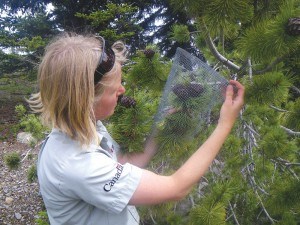
Tucked away in the subalpine of Jasper National Park, centuries-old giants struggle for survival.
Over the next few years, many towering whitebark pine will succumb to white pine blister rust, an invasive disease that is devastating white pine populations across the continent. Whitebark pine is a key species in subalpine ecosystems, and its disappearance could have major implications for species as small as squirrels and as big as grizzly bears.
“There is reason to be very concerned,” says Parks Canada Conservation Biologist Brenda Shepherd, who last week travelled to the whitebark pine stands of Pyramid Mountain. Of the 50 trees she counted, only three were free from infection.
“The disease came to Canada in the 1920’s on a load of wood from Europe,” says Shepherd, who adds that the decline has been exacerbated by climate change, fire suppression and mountain pine beetle outbreaks. The rust kills the trees by girdling them, thereby cutting off their food and water supply. The rust also attracts rodents and other animals to the trees, encouraging them to gnaw on the bark and contribute to the tree’s death.
The infection rate of white pine blister rust has been creeping upward for the past several decades. “It’s now over 50 per cent and increasing across stands we monitor from Waterton north to Jasper National Park,” says Shepherd. This pattern of decimation across the continent and elsewhere has led to the species being protected under the Species at Risk Act, and listed as endangered. The species was assessed by the Committee on the Status of Endangered Wildlife in Canada (COSEWIC) who deemed it as having “a high risk of extinction in the wild in the medium-term future.”
The COSEWIC report quotes whitebark pine scientist R.M. Lanner as saying the species “is so closely involved with other organisms that if it becomes extinct, or even seriously depleted, the effects will ramify throughout the ecosystem.” Whitebark pine is linked to animals primarily through its seeds. Like the pine nuts we sprinkle on salads, the seeds supply high calorie fuel for many birds and animals. Red squirrels harvest cones and store them in underground middens. These middens are often raided by both black bears and grizzly bears, and both bear species will also take cones directly from trees.
By far, the species with the most crucial relationship to whitebark pine is the Clark’s nutcracker, a bird that is primarily responsible for its distribution. The nutcracker uses its dagger-like beak to rip open the cones, and has evolved a “sub-lingual pouch” capable of storing up to 150 whitebark pine seeds at a time.
With a full pouch, seeds are carried and cached 10 to 15 at a time, just below the soil surface at various sites surrounding the mature tree. Inevitably, some of the caches will be forgotten and some seeds will germinate. Over the centuries, saplings will grow in rings around forgotten caches. Shepherd recently found a series of whitebark pine trees in this formation on a hike down the Astoria Trail.
On the same trip, Shepherd discovered a massive, powdery orange blister rust canker on one of the trees, a sign that the infection is taking hold. When you see photos of infected stands, it’s hard to believe the species will survive. However, Shepherd is quick to point out that the species is recoverable, and that a recovery strategy is underway both by Environment Canada and the Province of Alberta.
As part of those recovery efforts, Shepherd and colleagues throughout the mountain national parks continue to monitor whitebark pine health, and are also identifying whitebark pine trees that are resistant to the disease. Some cones on resistant trees are “caged” to prevent nutcrackers and other herbivores from taking the seeds. Later in the season, they are collected and sent to a lab so that researchers can identify resistant trees and grow out seedlings that can be planted in whitebark range to help with recovery.
Shepherd’s enthusiasm and appreciation for whitebark pine makes one want to see them. She suggests taking a walk down the Astoria Trail from the Mount Edith Cavell parking area. Within the first kilometre, you will find yourself standing among giants, listening to the nutcrackers calling around you.
Niki Wilson
Special to the 51����
